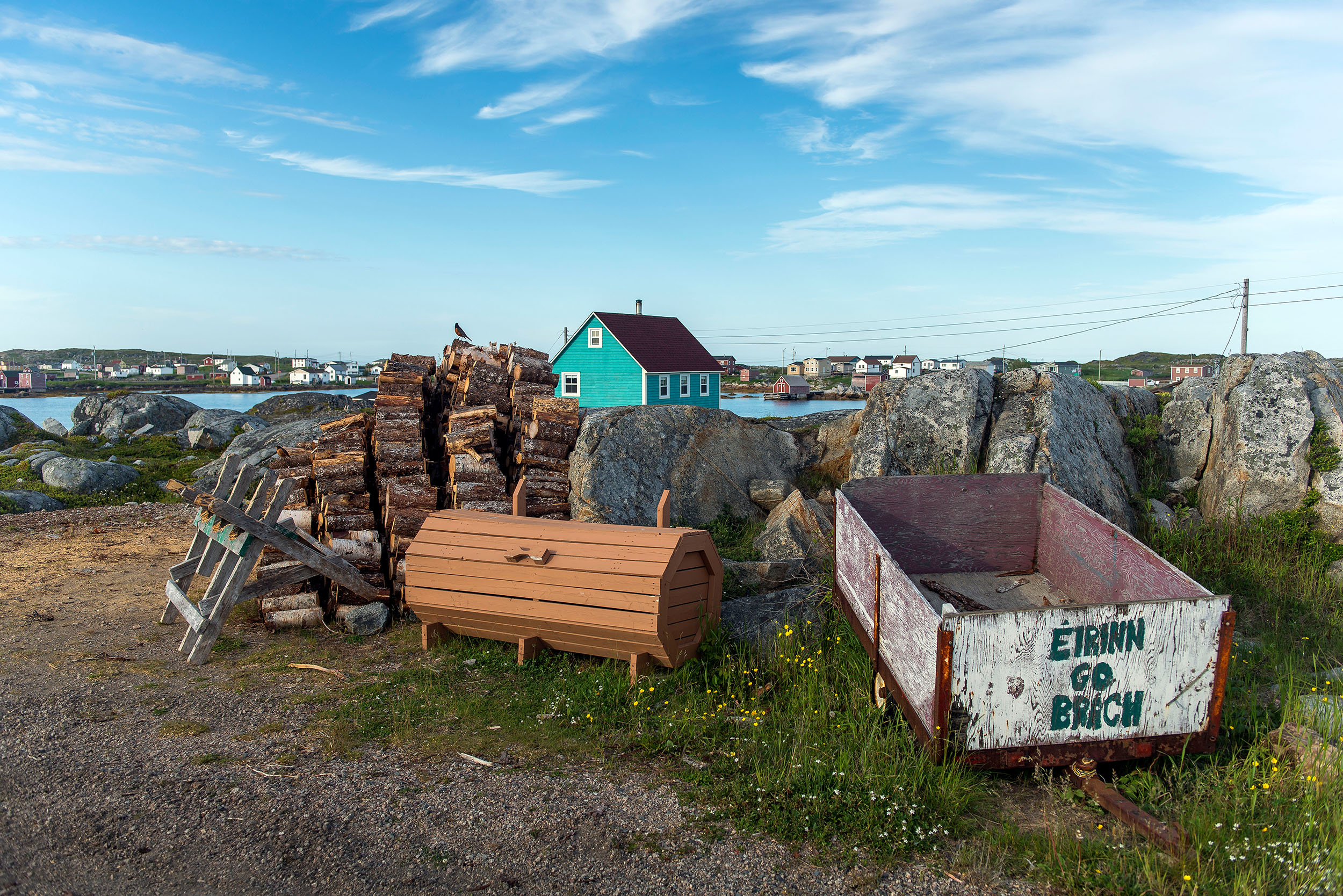The most Irish island in the world is in Canada
A Newfoundland community dubbed ‘Canada’s Emerald Isle’ is struggling to save its identity

Norm Foley outside of Foley’s Shed in Tilting (@joelandjustyna)
Share
As the winter sun rises over Tilting Harbour, Norm Foley is on Oliver’s Cove Beach, pitchfork in hand, green rubber boots over the pant legs of his Levi’s, iPhone in his shirt pocket. The 55-year-old will spend hours on this day spearing kelp from the shaggy maroon heaps that smother the shore, forking it into heavy-duty plastic containers.
Then, rope over his shoulder like a horse, he’ll tow container after container to his vegetable patch—the same plot of soil where his parents and their forebears grew potatoes when they arrived from Ireland in the 1730s.
It’s a practice that Foley’s ancestors brought from the shorelands of the old country, and one that kept them alive on the rugged, infertile land they settled. The kelp will rot over the winter, creating a rich fertilizer for carrots, parsnips and—yes—potatoes during the short growing season.
Such are the old ways of life in Tilting, a living artifact from the 2½ centuries of Irish migration that helped give Newfoundland its identity. A National Historic Site, the outport community on Fogo Island has survived relatively untouched for eight generations, and is so distinctively Celtic that the BBC called the area “Canada’s little-known Emerald Isle.” The Irish Times dubbed it “the most Irish island in the world,” and “Irish on the rocks.”

Tilting’s name is thought to derive from the humble shelters that the earliest Irish settlers to this part of northeast Newfoundland called “tilts.” And its location—tucked into a harbour without roads or a ferry, electricity or running water until the 1960s—helped preserve its old-world sensibility. Ochre fishing structures and fish flakes still cling to the rocky shores. One-and-a-half-storey saltbox houses stand in clusters on family plots of land, while fences made from spruce logs criss-cross the subarctic land, relics from a time when cattle and sheep roamed around the homesteads.
But with just 200 or so residents, Tilting faces the same fate as other Newfoundland outports, where children were once as plentiful as the cod. The local school closed years ago: the village’s remaining 17 kids are bussed to another part of Fogo, and many of their parents travel off-island for work. Foley, the youngest of six brothers, sees the Irish way of life disappearing: “We’re holding onto it but we’re having a job. It’s fading away.”
This March, for the third straight year, that sense of loss will intensify. No time of year gets residents thinking about the Irishness of the place like St. Patrick’s Day, an occasion that rivals Christmas on the local calendar. For decades, residents have gone from house to house for a drink and a song, then marched in parade from the St. Patrick Roman Catholic Parish Church to the parish hall for more revelry.
In recent years, people from all over Fogo Island have arrived on snowmobiles, dressed in green for a poker run. They’ve gone from cabin to cabin all day in the woods, eating and drinking, breaking into song. The merriment continued into the night at the parish hall.
But in a time of Omicron, cramming into kitchens and clustering around cabin stoves is something short of doctor-recommended. The parties will be “bubbled,” as they were last year, with a few buddies drinking beer in a shed.
It seems a blow to one of the last, vital links to Tilting’s identity. But like their counterparts in other parts of the province, people here take a practical view of the future—including the possibility that a less Irish version of their town will survive. Slowly, it’s becoming a place that celebrates its past rather than living it.
Nearly a decade ago, a luxury hotel called the Fogo Island Inn opened in the next village. Foley, who had recently moved back after working more than 20 years as a labourer building houses in Toronto and St. John’s, began selling his vegetables to the inn and hosting boil-ups for its guests, whose room-and-meal rates start at $2,575 a night.
The inn and the social enterprise charity that owns it have boosted the local economy. Young people and artists have been restoring saltbox homes and moving in, at least seasonally, and a café has opened. It’s not enough to restore the place to its pre-cod-moratorium heyday, but it’s providing local jobs.

How long the old, Irish version of Tilting has left is an open question, says Gerard Foley, a distant relative of Norm and a mayor of Tilting before it amalgamated with the Town of Fogo in 2011. “It’s hard to visualize what it’ll be in 15 or 20 years time,” says the 64-year-old in a discernibly Irish brogue. “Hopefully we can hold onto it for another while. It’s in our blood.”
For Norm Foley, providing food to the inn squares nicely with his way of life—one that, minus the iPhone, his ancestors might’ve lived a century ago. He lives in his parent’s home, kept just as his mother, Theresa, had it, with the woodstove lit from late summer to spring, floral wallpaper and portraits of Jesus hanging on every lintel.
He eats what he catches and grows, save the odd bottle of ketchup. He scythes his grass, salts and dries his cod, and pickles his own beets. He picks partridge berries, and dries his own herbs for soups and stews.
On March 17, Foley will don the same clothes he wears every St. Patrick’s Day for this year’s scaled-down, pandemic-friendly celebration: a light green parka, a T-shirt with a shamrock that says “Kiss me if you’re Irish,” and a green cap with “Tilting” written on it, given to him by his mother.
This article appears in print in the March 2022 issue of Maclean’s magazine with the headline, “Irish on the rocks.” Subscribe to the monthly print magazine here.